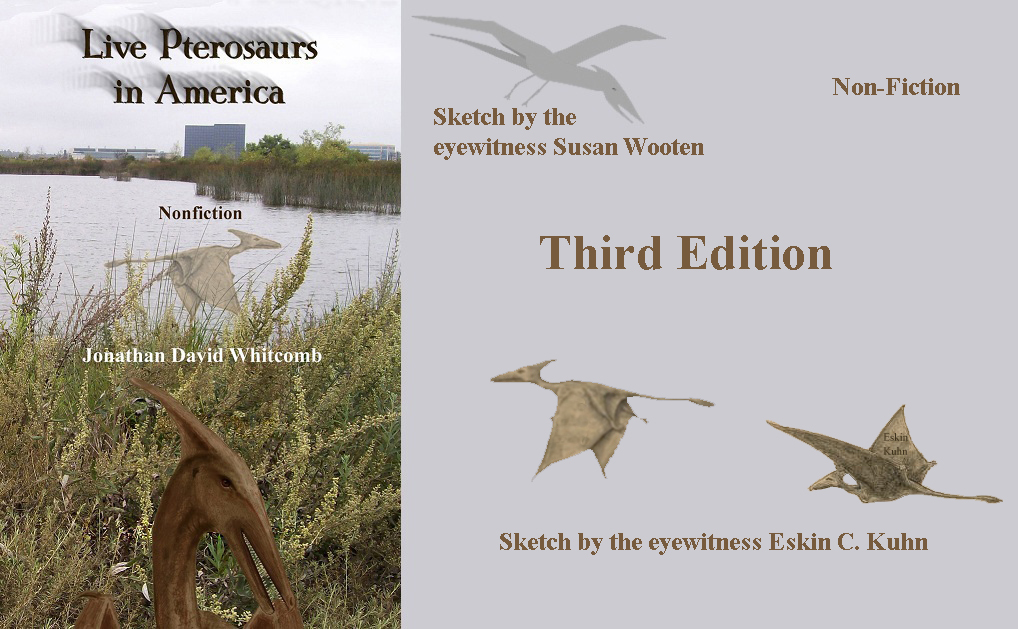What was the largest apparent pterosaur (living cryptid, not fossil bones) ever reported by an eyewitness? The Perth Creature (1997)? The Lake Pung Ropen (about 1994)? The Hodgkinson Pterodactyl (1944)? No eyewitness has ever measured one directly, so who can say? But it seems obvious, when we consider all of the most credible accounts together, that some living pterosaurs—older individuals, uncommon at least—have wingspans greater than twenty feet. Rather than try to find a winner for size, let’s consider several reports to get a general idea.
Pterosaur Sighting at Wildlife Sanctuary in Southern California
I myself measured the road over which that creature had flown: thirty feet wide. That is how we estimate the length of the apparent ropen that shocked a driver who saw it fly from a marsh into a wildlife sanctuary, right over the road, right in front of his car.
In July of 2008, I received a phone call from a man who reported a very large flying creature, seen one year earlier, in Orange County, less than one mile north of the University of California at Irvine. He described the dark gray or black animal as 30 feet long, with 15-16 feet of that being a tail. He saw the creature fly “at low altitude,” in front of his car, over the road (Campus Drive), into the San Joaquin Wildlife Sanctuary, in daylight.
I believe the creature’s flight path was not exactly perpendicular to the road, when it flew over it, from the best of my memory of interviewing the eyewitness, which brings up the possibility that it may have been even longer than thirty feet. It’s hard to find room for much exaggeration in this sighting: The ropen seems to have been close to thirty feet long.
. . . during World War II, the American Duane Hodgkinson and his army buddy were shocked to see one of the giant ropens fly into the air right after it was startled awake from a wild pig in a jungle clearing. Hodgkinson estimated the wingspan as similar to that of a Piper Tri-Pacer airplane, in other words about 29 feet. He estimated the tail length at about 10-15 feet, at least.
Some ropens have tails about 15 feet long, from the reports of the 2007 Southern California sighting and the 1944 Finschhafen sighting, which practically eliminates bird-or-bat misidentifications, for no bird or bat has a tail nearly that long. For those who might suggest that Hodgkinson saw the long legs of a bird and exaggerated the length of what he thought was a tail, consider this: The creature running through that jungle clearing in 1944 (to get airborne) was running WITH ITS FEET while the tail trailing behind was “at least” ten to fifteen feet long. For those who might suggest that the wildlife-sanctuary ropen was a misidentified bird having long feet, consider this: What bird has legs fifteen to sixteen feet long? (Remember this estimate comes from comparing it to the nearby road.)
The Australian couple who observed that flying creature (for some time, as it approached them slowly) were shocked by its size. The husband (who worked in a scientific field, according to the wife) told me that he felt that the wingspan was about fifty feet, but he wanted to rationalize it to be only thirty feet.
The seven boys ran home in terror, never to forget their encounter with the giant ropen that had flown over the surface of the crater lake. I interviewed three of the eyewitnesses in 2004, about ten years after that encounter. Gideon Koro pondered my question about tail length, looking back and forth at the ground to his left before answering assuredly, “sefan meetuh” (seven meters, or about 23 feet). That by itself eliminates the flying-fox-fruit-bat explanation, for that bat has a tail measured in fractions of an inch, not meters.
Buy this cryptozoology book on Amazon.com



